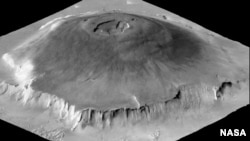A Martian volcano may have erupted continuously for more than 2 billion years, a new study suggests.
Writing in the journal Science Advances, researchers from Purdue University say they base their theory on a small meteorite found in Algeria in 2012.
According to the researchers, the meteorite is 2.4 billion years old and likely was jolted off the Martian surface when an object hit the planet, likely near a volcano or lava plain. Fragments of the planet’s surface created by the impact finally made their way to Earth.
Fragments from Mars have an easier time escaping the planet because of its low gravity and thinner atmosphere.
Today, Mars is still known for volcanos, including the largest in the solar system, Olympus Mons, which is the size of the U.S. state of Arizona and is over 27 kilometers high. Researchers can’t say if the meteorite came from Olympus Mons.
Volcanos on Mars can grow so big because of a lack of plate tectonics on the Red Planet. The planet’s crust is not constantly recycled as it is here.
Researchers say there have been 100 meteorites found on Earth that likely came from Mars. Most of them have been found in Antarctica and North Africa.
By analyzing the meteorites, researchers can figure out its age, magma source, the time the object was in space and how long it has been on Earth.
This specific meteorite, called NWA 7635, is one of 11 that Purdue University Physics and Astronomy Professor Marc Caffee has determined was exposed to cosmic rays for 1.1 million years.
"What we interpret from that is that all 11 were knocked off Mars at the same time," said the research team member. "But this one was different than the others."
The other 10 in the sample were all about 500 million years old “meaning they were formed from cooling magma half-a-billion years ago on the surface of Mars.” This meteorite, named NWA 2635, found in northwest Africa, is 2.4 billion years old.
"What this means is that for 2 billion years there's been sort of a steady plume of magma in one location on the surface of Mars," Caffee said. "We don't have anything like that on Earth, where something is that stable for 2 billion years at a specific location."









